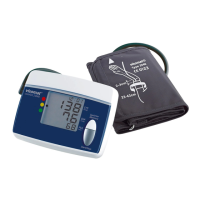
Do you have a question about the uebe Visomat Comfort 20 and is the answer not in the manual?
| Measurement Method | Oscillometric |
|---|---|
| Accuracy (Pressure) | ±3 mmHg |
| Accuracy (Pulse) | ±5% of reading |
| Memory | 30 readings |
| Cuff Size | 22 - 32 cm |
| Power Source | 4 x AA batteries |
| Operating Temperature | 10°C - 40°C |
| Measurement Range (Pulse) | 40 - 199 bpm |
| Storage Temperature | -20 to +60°C |
Key guidelines for safe and correct use of the blood pressure monitor by patients.
Crucial technical information regarding power supply, accessories, and potential interference.
Overview of the blood pressure monitor's components and their labels.
Explanation of the various symbols and indicators shown on the device's display.
Essential advice on preparation, body posture, and environmental factors for accurate measurements.
Steps for powering the device, including battery insertion or mains adapter connection.
Detailed instructions on how to open, insert, and close the battery compartment.
Step-by-step guide on how to correctly position and secure the blood pressure cuff on the arm.
Procedure for initiating and performing a blood pressure measurement using the device.
Explanation of how the device categorizes blood pressure readings using WHO guidelines.
Definition and significance of pulse pressure in relation to blood vessel health.
Information on the irregular pulse symbol and its potential causes or implications.
How to access, view, and delete stored measurement results and the average value.
Explanation of what systolic and diastolic pressure represent and their importance.
Factors that can cause blood pressure readings to vary.
Importance of consistent blood pressure monitoring for health assessment.
List of error codes, their possible causes, and recommended corrective actions.
Contact information for support and repair services for the device.
Specifications of the device, including measurement ranges, power, and dimensions.
List of international and national standards the device complies with.
Information on recommended calibration intervals and procedures for accuracy checks.
Interpretation of CE marking, protection degree, and other symbols used in the manual.
Guidelines for the environmentally responsible disposal of the device and batteries.
Technical description and guidance on EMC requirements and potential interference.
Details on immunity tests, compliance levels, and electromagnetic environments for the device.
Guidelines for maintaining safe distances from RF communication equipment to ensure device performance.
Details about the manufacturer's warranty, its duration, and terms and conditions.
